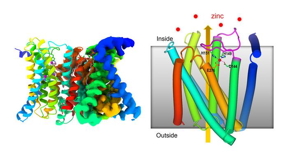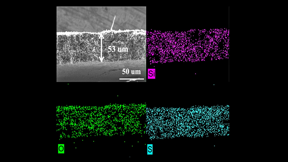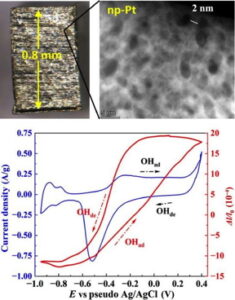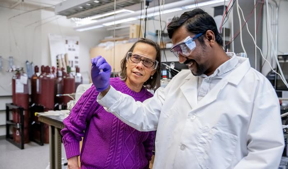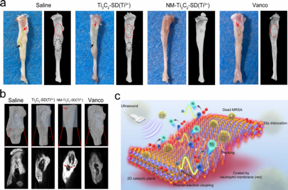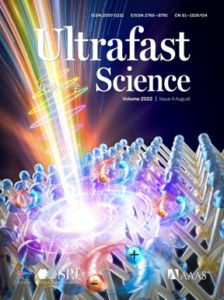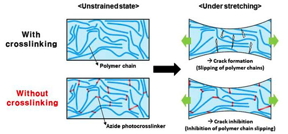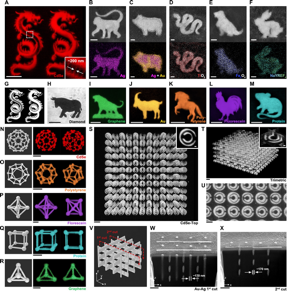Home > Press > With new experimental method, researchers probe spin structure in 2D materials for first time: By observing spin structure in “magic-angle” graphene, a team of scientists led by Brown University researchers have found a workaround for a long-standing roadblock in the field of two
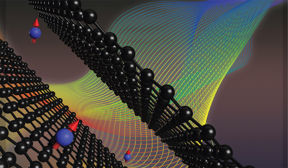 |
| By observing spin structure in “magic-angle” graphene, a team of scientists led by Brown University researchers have found a workaround for a long-standing roadblock in the field of two-dimensional electronics. CREDIT Jia Li/Brown University |
Abstract:
For two decades, physicists have tried to directly manipulate the spin of electrons in 2D materials like graphene. Doing so could spark key advances in the burgeoning world of 2D electronics, a field where super-fast, small and flexible electronic devices carry out computations based on quantum mechanics.
With new experimental method, researchers probe spin structure in 2D materials for first time: By observing spin structure in “magic-angle” graphene, a team of scientists led by Brown University researchers have found a workaround for a long-standing roadblock in the field of two
Providence, RI | Posted on May 12th, 2023Standing in the way is that the typical way in which scientists measure the spin of electrons — an essential behavior that gives everything in the physical universe its structure — usually doesn’t work in 2D materials. This makes it incredibly difficult to fully understand the materials and propel forward technological advances based on them. But a team of scientists led by Brown University researchers believe they now have a way around this longstanding challenge. They describe their solution in a new study published in Nature Physics.
In the study, the team — which also include scientists from the Center for Integrated Nanotechnologies at Sandia National Laboratories, and the University of Innsbruck — describe what they believe to be the first measurement showing direct interaction between electrons spinning in a 2D material and photons coming from microwave radiation. Called a coupling, the absorption of microwave photons by electrons establishes a novel experimental technique for directly studying the properties of how electrons spin in these 2D quantum materials — one that could serve as a foundation for developing computational and communicational technologies based on those materials, according to the researchers.
“Spin structure is the most important part of a quantum phenomenon, but we’ve never really had a direct probe for it in these 2D materials,” said Jia Li, an assistant professor of physics at Brown and senior author of the research. “That challenge has prevented us from theoretically studying spin in these fascinating material for the last two decades. We can now use this method to study a lot of different systems that we could not study before.”
The researchers made the measurements on a relatively new 2D material called “magic-angle” twisted bilayer graphene. This graphene-based material is created when two sheets of ultrathin layers of carbon are stacked and twisted to just the right angle, converting the new double-layered structure into a superconductor that allows electricity to flow without resistance or energy waste. Just discovered in 2018, the researchers focused on the material because of the potential and mystery surrounding it.
“A lot of the major questions that were posed in 2018 have still yet to be answered,” said Erin Morissette, a graduate student in Li’s lab at Brown who led the work.
Physicists usually use nuclear magnetic resonance or NMR to measure the spin of electrons. They do this by exciting the nuclear magnetic properties in a sample material using microwave radiation and then reading the different signatures this radiation causes to measure spin.
The challenge with 2D materials is that the magnetic signature of electrons in response to the microwave excitation is too small to detect. The research team decided to improvise. Instead of directly detecting the magnetization of the electrons, they measured subtle changes in electronic resistance, which were caused by the changes in magnetization from the radiation using a device fabricated at the Institute for Molecular and Nanoscale Innovation at Brown. These small variations in the flow of the electronic currents allowed the researchers to use the device to detect that the electrons were absorbing the photos from the microwave radiation.
The researchers were able to observe novel information from the experiments. The team noticed, for instance, that interactions between the photons and electrons made electrons in certain sections of the system behave as they would in an anti-ferromagnetic system — meaning the magnetism of some atoms was canceled out by a set of magnetic atoms that are aligned in a reverse direction.
The new method for studying spin in 2D materials and the current findings won’t be applicable to technology today, but the research team sees potential applications the method could lead to in the future. They plan to continue to apply their method to twisted bilayer graphene but also expand it to other 2D material.
“It's a really diverse toolset that we can use to access an important part of the electronic order in these strongly correlated systems and in general to understand how electrons can behave in 2D materials,” Morissette said.
The experiment was carried out remotely in 2021 at the Center for Integrated Nanotechnologies in New Mexico. Mathias S. Scheurer from University of Innsbruck provided theoretical support for modeling and understanding the result. The work included funding from the National Science Foundation, the U.S. Department of Defense and the U.S. Department of Energy’s Office of Science.
####
For more information, please click here
Contacts:
Juan Siliezar
Brown University
Office: 401-863-3766
Copyright © Brown University
If you have a comment, please Contact us.Issuers of news releases, not 7th Wave, Inc. or Nanotechnology Now, are solely responsible for the accuracy of the content.
| Related Links |
| Related News Press |
2 Dimensional Materials
![]() Breakthrough in the optical properties of MXenes - two-dimensional heterostructures provide new ideas May 12th, 2023
Breakthrough in the optical properties of MXenes - two-dimensional heterostructures provide new ideas May 12th, 2023
![]() Graphene grows – and we can see it March 24th, 2023
Graphene grows – and we can see it March 24th, 2023
![]() HKUMed invents a novel two-dimensional (2D) ultrasound-responsive antibacterial nano-sheets to effectively address bone tissue infection March 24th, 2023
HKUMed invents a novel two-dimensional (2D) ultrasound-responsive antibacterial nano-sheets to effectively address bone tissue infection March 24th, 2023
News and information
![]() Laser direct writing of Ga2O3/liquid metal-based flexible humidity sensors May 12th, 2023
Laser direct writing of Ga2O3/liquid metal-based flexible humidity sensors May 12th, 2023
![]() Breakthrough in the optical properties of MXenes - two-dimensional heterostructures provide new ideas May 12th, 2023
Breakthrough in the optical properties of MXenes - two-dimensional heterostructures provide new ideas May 12th, 2023
Graphene/ Graphite
![]() Graphene grows – and we can see it March 24th, 2023
Graphene grows – and we can see it March 24th, 2023
Govt.-Legislation/Regulation/Funding/Policy
![]() Researchers at Purdue discover superconductive images are actually 3D and disorder-driven fractals May 12th, 2023
Researchers at Purdue discover superconductive images are actually 3D and disorder-driven fractals May 12th, 2023
![]() Optical switching at record speeds opens door for ultrafast, light-based electronics and computers: March 24th, 2023
Optical switching at record speeds opens door for ultrafast, light-based electronics and computers: March 24th, 2023
![]() Robot caterpillar demonstrates new approach to locomotion for soft robotics March 24th, 2023
Robot caterpillar demonstrates new approach to locomotion for soft robotics March 24th, 2023
![]() Semiconductor lattice marries electrons and magnetic moments March 24th, 2023
Semiconductor lattice marries electrons and magnetic moments March 24th, 2023
Possible Futures
![]() Researchers at Purdue discover superconductive images are actually 3D and disorder-driven fractals May 12th, 2023
Researchers at Purdue discover superconductive images are actually 3D and disorder-driven fractals May 12th, 2023
![]() Laser direct writing of Ga2O3/liquid metal-based flexible humidity sensors May 12th, 2023
Laser direct writing of Ga2O3/liquid metal-based flexible humidity sensors May 12th, 2023
![]() Breakthrough in the optical properties of MXenes - two-dimensional heterostructures provide new ideas May 12th, 2023
Breakthrough in the optical properties of MXenes - two-dimensional heterostructures provide new ideas May 12th, 2023
![]() Novel design perovskite electrochemical cell for light-emission and light-detection May 12th, 2023
Novel design perovskite electrochemical cell for light-emission and light-detection May 12th, 2023
Chip Technology
![]() Laser direct writing of Ga2O3/liquid metal-based flexible humidity sensors May 12th, 2023
Laser direct writing of Ga2O3/liquid metal-based flexible humidity sensors May 12th, 2023
![]() Breakthrough in the optical properties of MXenes - two-dimensional heterostructures provide new ideas May 12th, 2023
Breakthrough in the optical properties of MXenes - two-dimensional heterostructures provide new ideas May 12th, 2023
Discoveries
![]() Laser direct writing of Ga2O3/liquid metal-based flexible humidity sensors May 12th, 2023
Laser direct writing of Ga2O3/liquid metal-based flexible humidity sensors May 12th, 2023
![]() Breakthrough in the optical properties of MXenes - two-dimensional heterostructures provide new ideas May 12th, 2023
Breakthrough in the optical properties of MXenes - two-dimensional heterostructures provide new ideas May 12th, 2023
![]() Novel design perovskite electrochemical cell for light-emission and light-detection May 12th, 2023
Novel design perovskite electrochemical cell for light-emission and light-detection May 12th, 2023
Announcements
![]() Laser direct writing of Ga2O3/liquid metal-based flexible humidity sensors May 12th, 2023
Laser direct writing of Ga2O3/liquid metal-based flexible humidity sensors May 12th, 2023
![]() Breakthrough in the optical properties of MXenes - two-dimensional heterostructures provide new ideas May 12th, 2023
Breakthrough in the optical properties of MXenes - two-dimensional heterostructures provide new ideas May 12th, 2023
![]() Novel design perovskite electrochemical cell for light-emission and light-detection May 12th, 2023
Novel design perovskite electrochemical cell for light-emission and light-detection May 12th, 2023
Interviews/Book Reviews/Essays/Reports/Podcasts/Journals/White papers/Posters
![]() Researchers at Purdue discover superconductive images are actually 3D and disorder-driven fractals May 12th, 2023
Researchers at Purdue discover superconductive images are actually 3D and disorder-driven fractals May 12th, 2023
![]() Laser direct writing of Ga2O3/liquid metal-based flexible humidity sensors May 12th, 2023
Laser direct writing of Ga2O3/liquid metal-based flexible humidity sensors May 12th, 2023
![]() Breakthrough in the optical properties of MXenes - two-dimensional heterostructures provide new ideas May 12th, 2023
Breakthrough in the optical properties of MXenes - two-dimensional heterostructures provide new ideas May 12th, 2023
![]() Novel design perovskite electrochemical cell for light-emission and light-detection May 12th, 2023
Novel design perovskite electrochemical cell for light-emission and light-detection May 12th, 2023
Military
![]() New experiment translates quantum information between technologies in an important step for the quantum internet March 24th, 2023
New experiment translates quantum information between technologies in an important step for the quantum internet March 24th, 2023
![]() Optical switching at record speeds opens door for ultrafast, light-based electronics and computers: March 24th, 2023
Optical switching at record speeds opens door for ultrafast, light-based electronics and computers: March 24th, 2023
![]() Semiconductor lattice marries electrons and magnetic moments March 24th, 2023
Semiconductor lattice marries electrons and magnetic moments March 24th, 2023
![]() Make them thin enough, and antiferroelectric materials become ferroelectric February 10th, 2023
Make them thin enough, and antiferroelectric materials become ferroelectric February 10th, 2023
- SEO Powered Content & PR Distribution. Get Amplified Today.
- PlatoAiStream. Web3 Data Intelligence. Knowledge Amplified. Access Here.
- Minting the Future w Adryenn Ashley. Access Here.
- Buy and Sell Shares in PRE-IPO Companies with PREIPO®. Access Here.
- Source: http://www.nanotech-now.com/news.cgi?story_id=57341
- :has
- :is
- :not
- :where
- 10
- 10th
- 2018
- 2021
- 27
- 2D
- 2D materials
- 3d
- a
- Able
- access
- According
- accuracy
- actually
- address
- advanced
- advances
- AI
- aligned
- allows
- also
- an
- and
- applicable
- applications
- Apply
- approach
- April
- ARE
- around
- artificial
- artificial intelligence
- AS
- Assistant
- At
- author
- based
- BE
- because
- become
- before
- believe
- between
- BONE
- Breaking
- Brown University
- but
- by
- called
- CAN
- canceled
- carbon
- carry
- caused
- causes
- Center
- certain
- CGI
- challenge
- challenges
- Changes
- click
- COM
- coming
- comment
- commercialisation
- computations
- computers
- computing
- content
- continue
- converting
- could
- created
- credit
- Current
- deal
- debate
- decades
- decided
- Defense
- demonstrates
- Department
- department of defense
- describe
- Design
- developing
- device
- Devices
- different
- difficult
- direct
- direction
- directly
- discover
- discovered
- diverse
- do
- Doesn’t
- doing
- Door
- effectively
- electricity
- Electronic
- Electronics
- electrons
- end
- energy
- energy waste
- enough
- essential
- establishes
- Ether (ETH)
- everything
- exciting
- Expand
- experiment
- experiments
- fascinating
- February
- field
- findings
- First
- first time
- flexible
- flow
- focused
- For
- Forward
- found
- Foundation
- from
- fully
- funding
- future
- General
- gif
- gives
- Global
- graduate
- Graphene
- Grows
- had
- Have
- help
- How
- http
- HTTPS
- identify
- if
- images
- important
- in
- Inc.
- include
- included
- incredibly
- information
- Innovation
- instance
- instead
- Institute
- integrated
- Intelligence
- interaction
- interactions
- International
- into
- IT
- ITS
- just
- Key
- lab
- landmark
- Last
- layers
- lead
- Led
- like
- links
- long-standing
- Lot
- made
- Magnetism
- major
- MAKES
- March
- material
- materials
- May..
- meaning
- measure
- measurement
- measurements
- mechanics
- method
- Mexico
- modeling
- molecular
- more
- most
- Mystery
- nanotechnology
- National
- National Science
- Nature
- net
- never
- New
- news
- novel
- now
- nuclear
- observe
- of
- Office
- on
- ONE
- opens
- or
- order
- Origin
- Other
- out
- part
- phenomenon
- Photons
- Photos
- PHP
- physical
- Physics
- plan
- plato
- Plato Data Intelligence
- PlatoData
- please
- Post
- posted
- potential
- press
- Press Release
- probe
- Professor
- Propel
- properties
- provide
- provided
- published
- Quantum
- quantum information
- quantum materials
- Quantum Mechanics
- Questions
- Radiation
- Reading
- really
- record
- relatively
- release
- Releases
- research
- researcher
- researchers
- Resistance
- resonance
- response
- responsible
- result
- return
- reverse
- right
- s
- Said
- Save
- Science
- scientists
- Search
- sections
- see
- sees
- senior
- serve
- set
- settles
- Share
- Signatures
- Signs
- small
- So
- Soft
- solution
- some
- Spark
- speeds
- Spin
- stacked
- start
- Step
- Still
- strongly
- structure
- Student
- Study
- Studying
- submit
- support
- Surrounding
- Sustainability
- system
- Systems
- tackle
- team
- technological
- Technologies
- Technology
- that
- The
- The Future
- their
- Them
- then
- theoretical
- These
- they
- this
- those
- time
- to
- today
- too
- Trevor
- tried
- two
- typical
- u.s.
- U.S. Department of Defense
- understand
- understanding
- Universe
- university
- us
- use
- using
- usually
- was
- Waste
- Wave
- Way..
- we
- were
- What
- when
- which
- WHO
- with
- without
- Work
- world
- would
- writing
- Yahoo
- yet
- you
- zephyrnet











